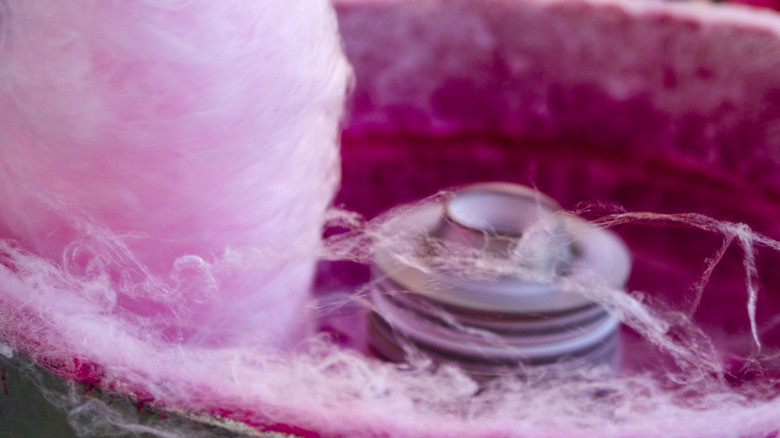This Is Why Cotton Candy Is So Fluffy
Do you remember the first time you tried cotton candy at a fair? Via a TikTok video, you can relive the moment vicariously with a video of a little girl having her first-ever cotton candy tasting experience. Trust us, stop what you're doing right now and bask in this toddler's initial shock then delightful glee at the utter deliciousness of it. You're welcome.
Invented by dentist William Morrison and John C. Wharton, a candy maker, cotton candy was originally called "fairy floss," and it first appeared at the 1904 St. Louis World Fair. To say fairgoers liked it would be an understatement. According to Wonderopolis, the duo sold over 68,000 boxes of the sweet snack for 25 cents each (half the price of a ticket to the fair itself). In the last 100-plus years, cotton candy has made its tasty rounds across the globe, delighting all creatures big and small, from the Netherlands where it's known as "sugar spider" to Greece where it's endearingly called "old lady's hair," per Smithsonian Magazine.
Part of the joy we feel about cotton candy, though, doesn't come from just the taste. It comes from the fact that as kids and adults, even though we've seen it being made, spinning sugar into something that looks like, well, old lady's hair, still feels like a magic trick. How can something look like a cotton ball and melt in your mouth like a snowflake? According to The Daily Meal, it's science.
Fluffy cotton candy is all about centrifugal force
A modern cotton candy machine is basically the same as the one Morrison and Wharton first used back in the early 20th century to spin their O.G. of fluff, only less noisy, shaky, and generally more reliable (via How Stuff Works). There's a spinning head dotted with tiny holes inside a huge metal bowl. At the top of the head, there's a heater that melts the sugar, forming it into a syrup. While this is happening, the head is doing its thing, spinning and generating an ungodly amount of centrifugal force — 3,400 revolutions per minute. Yep, the sugar is going for a ride on its own personal amusement park Gravitron. This force pushes the liquid sugar through the tiny holes, solidifying it into super skinny, soft strands. And we're talking super skinny, like, 2,000ths of an inch in diameter skinny (via Wonderopolis).
Since the syrup cools as soon as it touches the air, the sucrose molecules that make up the syrup never get a chance to rearrange as crystals. Instead, they freeze into very fine sugar glass fibers, sort of like actual fiberglass. The machine that makes actual fiberglass is pretty similar to a cotton candy machine, per Science ABC. So really, "what you're eating, when you chow down on a giant poof of cotton candy, is the sugar version of glass" (via National Geographic). The more you know, right?

